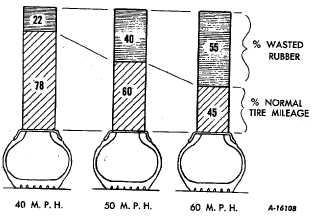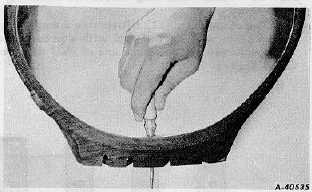|
| |
TRUCK SERVICE MANUAL
TM 5-4210-230-14&P-1
WHEELS, RIMS, TIRES
SPEEDS
Excessive speed is definitely one of the most important
factors in loss of tire mileage. The chart (Fig. 13) illustrates
how an increase in speed from 40 to 50 mph results in 18%
loss in mileage. An increase of speed from 40 to 60 mph
results in a 33% mileage loss.
Fig. 13. Speed vs. Mileage
TIRE MATCHING (Dual Tires)
Use care in matching dual tires. Tires which differ
more than 1/4" in diameter or 3/4" in circumference should not
be mounted on the same dual wheel. Should it become
necessary to mount two tires of unequal size on the same
dual wheel, place the larger or less worn tire on the outside.
TIRE MATCHING (Tandem Drive Axles)
When mounting tires on tendem drive axles, follow the
same instructions as specified for dual tires. However, never
install the four largest tires on one driving axle and the four
smallest on the other. This method of tire mounting will cause
high lubricant temperatures which may lead to premature axle
failures.
TIRE REPAIR
Methods for repairing tires will vary slightly with each
manufacturer
and
it
is
recommended
that
the
tire
manufacturers' procedures be followed if possible. However,
the procedure outlined here applies in general to most tires
whether they are light duty or heavy duty. Patching will usually
be satisfactory for all injuries up to 3/16" diameter. Larger
injuries should be handled by spot or section repair methods.
The first four steps given here apply to both the hot and cold
patch methods.
NOTE: Some tire repair methods for simple punctures
do not require the dismounting of tire from rim. These
methods should be regarded as temporary fixes since there is
a good chance of ply separation and ultimate tire failure can
result when puncture plug is installed from the outside.
1.
Remove tire and wheel assembly and inflate the tire to
the recommended pressure. Locate the leak and mark
with a crayon. It may be necessary to immerse the tire
in water or apply a coat of soapsuds to the tire to locate
the leak. Demount the tire. Probe the injury with an awl
(Fig. 14) to remove the puncturing object and foreign
material.
Fig. 14
Fig. 15
2.
Thoroughly clean the inside of the tire around the injury
with rubber solvent and allow to dry. As a safety
precaution, solvent vapors should be blown out of the
tire with compressed air. Solvent is not needed
CTS-2032N Page 6
PRINTED IN UNITED STATES OF AMERICA
|



